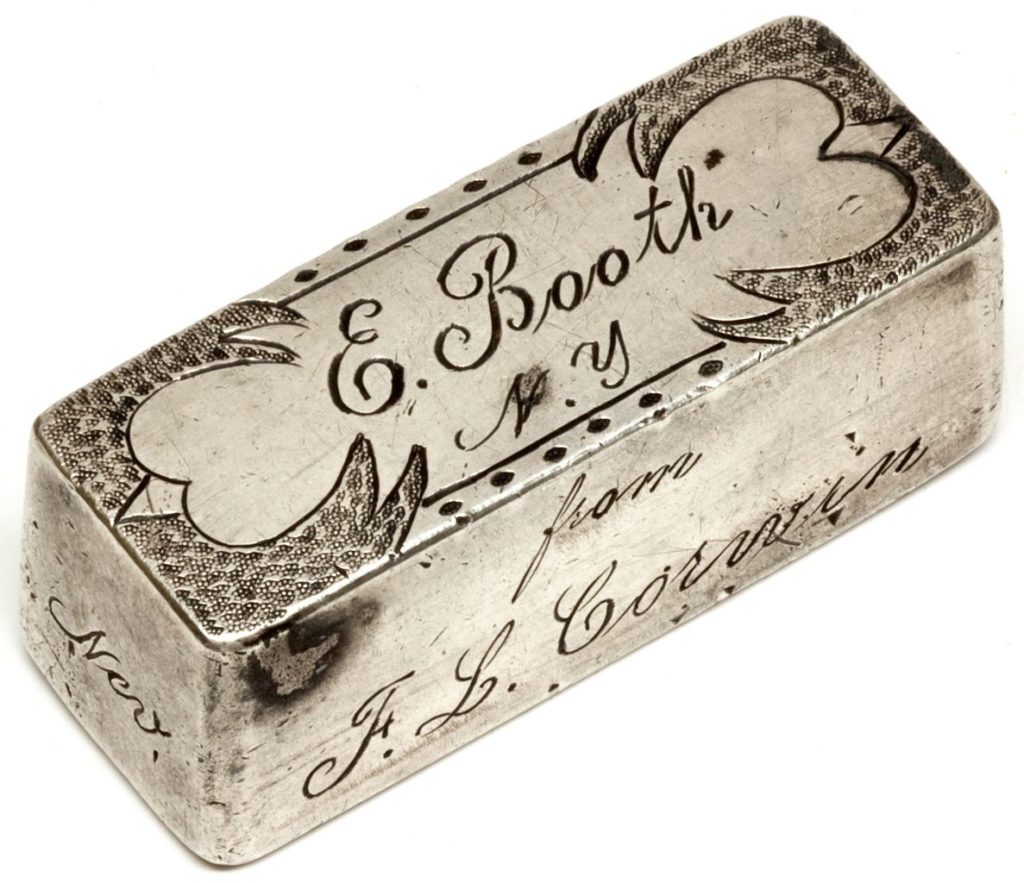4.7 oz F. L. Corwin Presentation Silver Ingot NV – Pioche, Lincoln County – c1871

This ingot is comes from a collection in the East. It is a presentation ingot, engraved “from F.L. Corwin” to E. Booth of New York, marked “Pioche, Nev.” on the two ends of the ingot. It measures 1.75” long, 0.6” wide and 0.6” thick. Engraved on four of the six sides, it does not contain any information on the weight or fineness, though it weighs 4.2 troy ounces of silver.
Frederick L. Corwin was an agent for an unnamed Express Company in Hamilton, Nevada according to the 1870 census. Born in New York in 1844, the son of William and Mark Corwin, the family moved to St. Louis Missouri, where William was a “hatter”, or the proprietor of a Hat shop. He was apparently an only child. After checking with Wells Fargo archives, he was not associated with them, whose agent at the time was Homer S. King, late r a very prominent San Francisco broker. The only other express company at the time was the Hamilton, Eberhardt, Shermantown Express, and then in 1872 the Hickox & Co.’s Express, both of which advertised in the White Pine News. Corwin is also not mentioned in Jackson’s Treasure Hill, Read’s White Pine Lang Syne or Patera’s work on Hamilton and Treasure. As an express agent, Corwin had the opportunity to meet all of the passengers coming and going from Hamilton, which was the center of the White Pine mining region. Undoubtedly, Miss E. Booth was a passenger or an acquaintance from home. Frederick Corwin was born in New York about 1844, but was only found in the 1870 census, and no others. He was also not found in other 1870’s Nevada Business directories, though only the Wells Fargo Express agents are listed in the Langley 1867, 1871-3 or 1876-8 Pacific Coast Business directory (coverage of Eberhardt was missing in the 1871 directory).
Express agents in the Pioche/Treasure City/Hamilton region were taking on a risky job. Their mining camps were far from any other civilization, with perhaps Austin, Nevada the closest large mining camp, but the nearest city of consequence was Salt Lake City. Thus they were greatly isolated. As such, stage robberies were a constant, and any agent had to be careful of the many bullion shipments leaving daily. At times there were reported as many as ten stages a day entering or leaving Pioche or Hamilton.
The ingot is ornately engraved with Booth’s name inside two hearts. My own guess is that Corwin and booth later married and disappeared from the US Census by working in a remote Nevada mining camp or moving to Europe. The pair is invisible after about 1872. This also leaves room for a possible murder of a stage agent, though much more research is necessary.
This is the first silver ingot to surface from Pioche, a major silver mining camp in central eastern Nevada. Pioche produced $133 million in bullion from the 1860’s to 1958, a conservative figure. Much more was produced from the Pan American mine after that period from replacement deposits. The town was a major eastern Nevada mining camp in the 1870’s, and today still retains much of its charm.
[08/2012] https://www.icollector.com/F-L-Corwin-Presentation-Silver-ingot-NV-Pioche-Lincoln-County-c1871-2012aug-Numismatic_i13391249 ($16,431)
